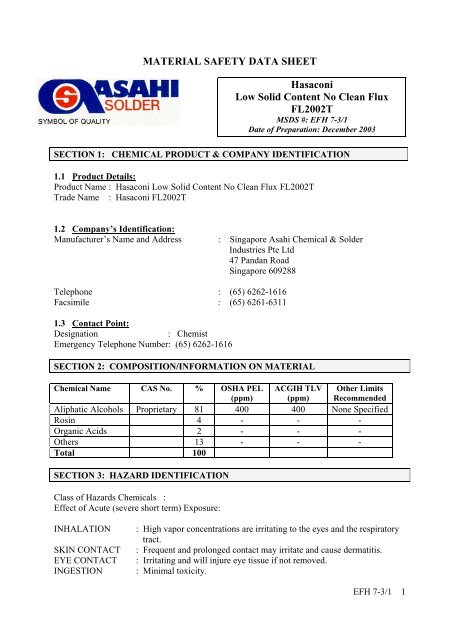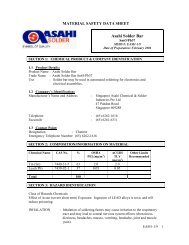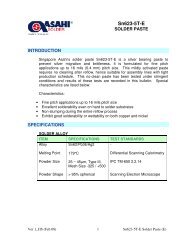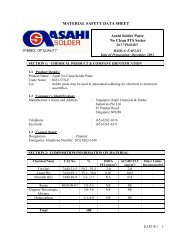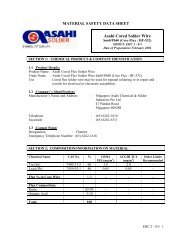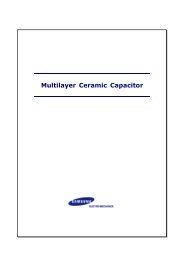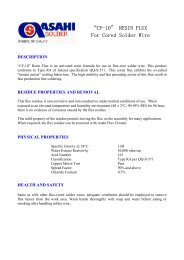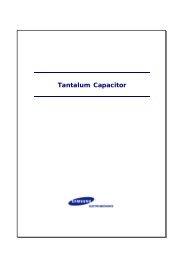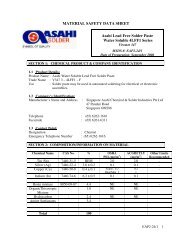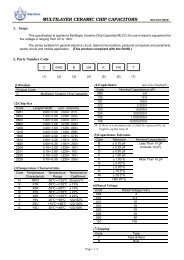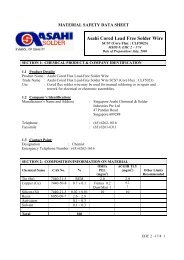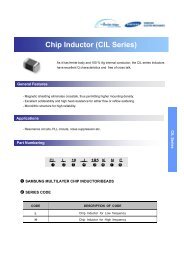MATERIAL SAFETY DATA SHEET
MATERIAL SAFETY DATA SHEET
MATERIAL SAFETY DATA SHEET
You also want an ePaper? Increase the reach of your titles
YUMPU automatically turns print PDFs into web optimized ePapers that Google loves.
<strong>MATERIAL</strong> <strong>SAFETY</strong> <strong>DATA</strong> <strong>SHEET</strong><br />
Hasaconi<br />
Low Solid Content No Clean Flux<br />
FL2002T<br />
MSDS #: EFH 7-3/1<br />
Date of Preparation: December 2003<br />
SECTION 1: CHEMICAL PRODUCT & COMPANY IDENTIFICATION<br />
1.1 Product Details:<br />
Product Name : Hasaconi Low Solid Content No Clean Flux FL2002T<br />
Trade Name : Hasaconi FL2002T<br />
1.2 Company’s Identification:<br />
Manufacturer’s Name and Address : Singapore Asahi Chemical & Solder<br />
Industries Pte Ltd<br />
47 Pandan Road<br />
Singapore 609288<br />
Telephone : (65) 6262-1616<br />
Facsimile : (65) 6261-6311<br />
1.3 Contact Point:<br />
Designation<br />
: Chemist<br />
Emergency Telephone Number: (65) 6262-1616<br />
SECTION 2: COMPOSITION/INFORMATION ON <strong>MATERIAL</strong><br />
Chemical Name CAS No. % OSHA PEL<br />
(ppm)<br />
ACGIH TLV<br />
(ppm)<br />
Other Limits<br />
Recommended<br />
Aliphatic Alcohols Proprietary 81 400 400 None Specified<br />
Rosin 4 - - -<br />
Organic Acids 2 - - -<br />
Others 13 - - -<br />
Total 100<br />
SECTION 3: HAZARD IDENTIFICATION<br />
Class of Hazards Chemicals :<br />
Effect of Acute (severe short term) Exposure:<br />
INHALATION<br />
SKIN CONTACT<br />
EYE CONTACT<br />
INGESTION<br />
: High vapor concentrations are irritating to the eyes and the respiratory<br />
tract.<br />
: Frequent and prolonged contact may irritate and cause dermatitis.<br />
: Irritating and will injure eye tissue if not removed.<br />
: Minimal toxicity.<br />
EFH 7-3/1 1
SECTION 4: FIRST AID MEASURES<br />
Ingestion : Do not induce vomiting. Keep at rest. See physician.<br />
Eye Contact : Flush eyes with large amounts of water for at least 15 minutes. Get prompt<br />
medical attention.<br />
Skin Contact : Flush with large amounts of water. Remove soiled clothing.<br />
Inhalation : Using respiratory protection, immediately remove victim from exposure.<br />
Administer CPR if breathing has stopped. Call for prompt medical attention.<br />
SECTION 5: FIRE-FIGHTING MEASURES<br />
Extinguishing Media<br />
: Use water spray to cool fire exposed surfaces and to<br />
protect personnel. Shut off “fuel” to fire.<br />
Fire Fighting Instructions : If leak/spill hasn’t ignited, use water spray to disperse<br />
vapors. Allow fire to burn under controlled conditions<br />
or extinguish with alcohol type foam/dry chemical.<br />
Unusual Fire and Explosion Hazards : Flammable liquid, can release vapors that form<br />
flammable mixtures at temperatures at or above the<br />
flashpoint. Try to cover liquid spills with foam.<br />
SECTION 6: ACCIDENTAL RELEASE MEASURES<br />
Leak/Spill<br />
: Eliminate sources of ignition. Prevent additional discharge of material, if<br />
possible to do without hazard. For small spills implements cleanup<br />
procedures. Vapors/dust can be harmful/fatal. Warn occupants of downwind<br />
areas.<br />
SECTION 7: HANDLING AND STORAGE<br />
Handling<br />
Storage<br />
: Wash hand thoroughly with soap and water prior to eating,<br />
drinking or smoking. Avoid inhalation of vapors and contact with skin<br />
and eyes. Observe good industrial practices.<br />
: Store in a cool environment. Do not expose containers to heat, flame,<br />
sparks, static electricity, or other sources of ignition. Explosion<br />
hazard. Empty containers should be drained and properly disposed of.<br />
SECTION 8: EXPOSURE CONTROL AND PERSONAL PROTECTION<br />
Engineering Measures : Maintain general or local exhaust ventilation to meet<br />
exposure limit requirements.<br />
Respiratory Protection : NIOSH/MSHA approved respirators may be necessary to<br />
prevent overexposure by inhalation.<br />
Protective Gloves : Chemical resistant gloves.<br />
Eye Protection<br />
: Wear safety glasses with side shields.<br />
Other Protective Equipments : For open systems where contact is likely, wear long sleeves,<br />
chemical resistant gloves and chemical goggles.<br />
Work Hygienic Practices : Do not eat, drink, or smoke in work area.<br />
Suppl. Safety & Health Data : WARNING: FLAMMABLE!<br />
EFH 7-3/1 2
SECTION 9: PHYSICAL AND CHEMICAL PROPERTIES<br />
Appearance<br />
: Clear transparent light amber liquid<br />
Odor<br />
: Alcohol odor<br />
Solubility in water:<br />
: Slightly soluble<br />
Boiling Point(°C) : 78°C<br />
Melting Point(°C)<br />
: NE<br />
Vapor Pressure(mm of Hg at 20°C) : NE<br />
Vapor Density (air=1)<br />
: NA<br />
Percentage Volatiles (by Volume) : NE<br />
Volatile Organic Compound (VOC) : ~ 90%<br />
Evaporation Rate (butyl acetate=1) : NE<br />
Specific Gravity (water=1 at 25°C) : 0.811 ± 0.005 @ 25°C<br />
Flash Point (°C)<br />
: 11.7°C by TCC<br />
Lower Explosive Limit<br />
: NE<br />
Upper Explosive Limit : 2.5<br />
Auto-ignition Temperature(°C) : 455.6°C<br />
SECTION 10: PHYSICAL HAZARDS (STABILITY AND REACTIVITY)<br />
Stability<br />
Condition to avoid<br />
Incompatibles<br />
Decomposition products<br />
Hazardous polymerization<br />
: Stable.<br />
: Direct contact with flame and excessive heating<br />
: Caustics, amines, alkanolamines, aldehydes, strong oxidizing<br />
agents, and chlorinated compounds.<br />
: None specified.<br />
: Will not occur.<br />
SECTION 11: TOXICOLOGICAL INFORMATION<br />
Toxicity data : None.<br />
Carcinogenicity : Not listed.<br />
Reproductive Effect : None.<br />
Effects of overexposure (Chronic Effect):<br />
Inhalation : May cause headache and dizziness, are anesthetic and may have other<br />
central nervous system effects.<br />
Ingestion<br />
: Small amounts of the liquid aspirated into the respiratory systems<br />
during ingestion, or from vomiting may cause bronchiopneumonia or<br />
pulmonary edema.<br />
Target Organs : Respiratory system.<br />
Medical Conditions Generally Aggravated by Exposure : None specified.<br />
SECTION 12: ECOLOGICAL INFORMATION<br />
Mobility & Bioaccumulation : Volatile material.<br />
Biodegradability<br />
: Non biodegradable.<br />
Aquatic Toxicity<br />
: NE<br />
EFH 7-3/1 3
SECTION 13: DISPOSAL INFORMATION<br />
Dispose according to federal, state and local regulations. If in doubt, contact Singapore Asahi.<br />
SECTION 14: TRANSPORT INFORMATION<br />
Hazard Class : 3<br />
UN Number : 1993<br />
PSN<br />
: Flammable Liquid n.o.s. (Isopropyl Alcohol)<br />
Special shipping instruction : NA<br />
SECTION 15: REGULATORY INFORMATION<br />
a. Proposed classification : Harmful.<br />
b. Risk phrase<br />
R11 Highly flammable.<br />
R20/21/22 Harmful by inhalation, in contact with skin and if swallowed<br />
R36/37/38 Irritating to the eyes, respiratory system and skin.<br />
c. Safety phrase<br />
S3/7/9 Keep container tightly closed, in a cool well ventilated place.<br />
S20/21 When using do not eat, drink or smoke.<br />
S23 Do not breathe fume or vapor.<br />
S24/25/26 Avoid contact with skin or eyes. In case of contact with skin,<br />
rinse immediately with plenty of water.<br />
S36/37/39 Wear suitable protective clothing, gloves and eye/face protection.<br />
S47/49 Keep only in the original container at temperature not exceeding 25°C.<br />
S59 Refer to manufacturer/supplier for information on recovery/recycling.<br />
SECTION 16: OTHER INFORMATION<br />
THIS INFORMATION RELATES ONLY TO THE SPECIFIC <strong>MATERIAL</strong> DESIGNATED<br />
AND MAY NOT BE VALID FOR SUCH <strong>MATERIAL</strong> USED IN COMBINATION WITH<br />
ANY OTHER <strong>MATERIAL</strong>S OR IN ANY PROCESS. SUCH INFORMATION IS TO THE<br />
BEST OF THE COMPANY’S KNOWLEDGE AND BELIEVED ACCURATE AND<br />
RELIABLE AS OF THE DATE INDICATED.<br />
HOWEVER, NO REPRESENTATION, WARRANTY OR GUARANTEE IS MADE AS TO<br />
ITS ACCURACY, RELIABILITY OR COMPLETENESS. IT IS THE USER’S<br />
RESPONSIBILITY TO SATISFY HIMSELF AS TO THE SUITABILITY AND<br />
COMPLETENESS OF SUCH INFORMATION FOR HIS OWN PARTICULAR USE.<br />
*optional<br />
NE = Not Established<br />
NA = Not Applicable<br />
PEL = Permissible Exposure Level<br />
EFH 7-3/1 4


